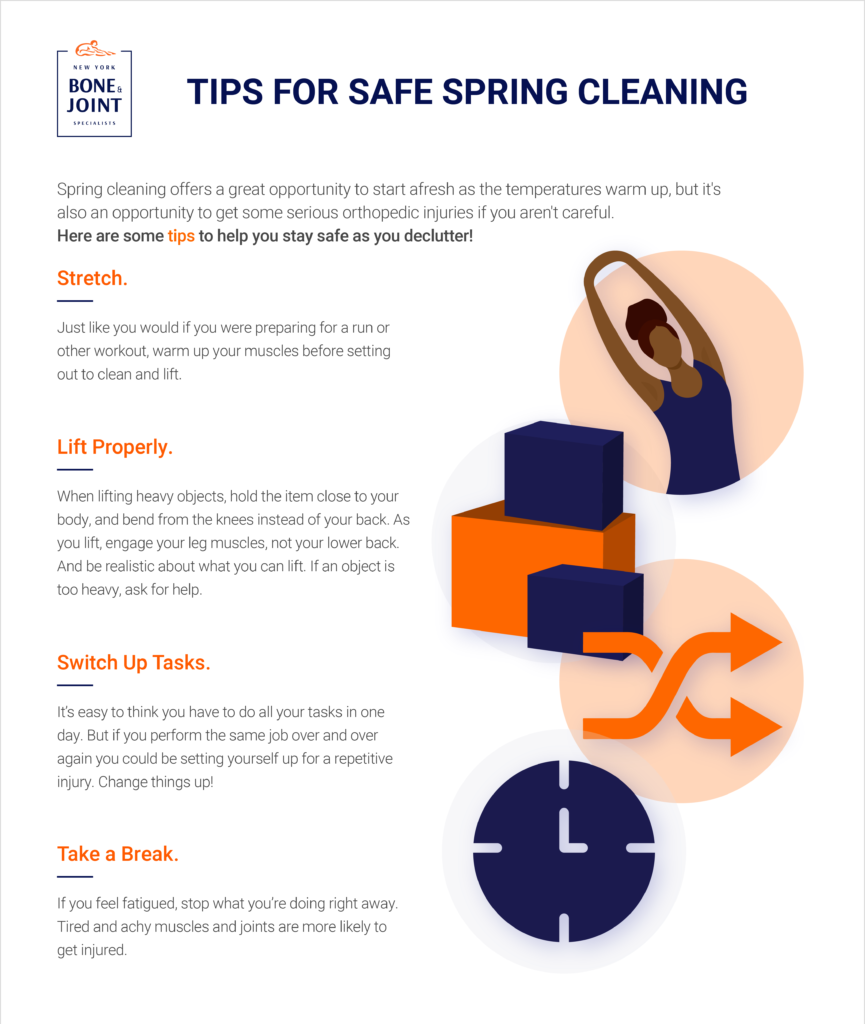Many orthopedic injuries happen in the home, and spring cleaning is a perfect time to strain your muscles and joints. Learn about the most common injuries and how to prevent them.
It’s spring, and it’s time to clear away the clutter and tackle those home-based projects you put off during the colder winter months. Spring cleaning offers the opportunity to start afresh as the temperatures warm up. Whether you’re trying to dust every nook and cranny or getting unused items ready for a yard sale, all that furious cleaning and lifting brings the risk of an orthopedic injury.
While people tend to think about orthopedic injuries occurring on the playing field, serious injuries can happen in the home too. The National Safety Council recorded 39.4 million home and community-related injuries requiring medical attention in 2019. If you want to stay safe and healthy this spring, make sure to take precautions before you dig into your spring cleaning tasks.
Common Spring Cleaning Orthopedic Injuries
Spring cleaning is a great way to start afresh with a decluttered, spotless home. Yet lifting, bending, hauling, and scrubbing can take a toll on your joints and muscles. Most of the injuries occur because of overuse or not using the proper technique. Here are some common spring cleaning injuries:
Tennis Elbow. You don’t need to swing a tennis racket to suffer from tennis elbow, an inflammation of the tendon in the outer elbow. Anytime you lift a heavy package you put extra stress on your elbow tendons, as well as your forearm and wrist muscles, leading to painful tendonitis.
Rotator Cuff Injury. Repeated lifting and reaching for heavy objects can result in either a tear or irritation of the rotator cuff muscles and tendons that support the shoulder joint. Pain and stiffness are typical symptoms of a rotator cuff injury.
Wrist/Ankle Injuries. A big part of spring cleaning is often tossing out unused items. But as you lift and move those objects, you can overextend the wrist and ankle joints, leading to a sprain or tear in the ligaments connecting those joints. Walking over piles of discarded items can also cause you to slip and fall, which can break a wrist or ankle bone.
Back Injuries. Spring cleaning inevitably involves a lot of lifting, bending, and unnatural twisting of the back. But those repetitive movements often lead to sore back muscles or worse back injuries.
How to Prevent Spring Cleaning Orthopedic Injuries
Spring cleaning may not be a welcome yearly chore, but it doesn’t have to be one that causes pain. You can avoid injuries and keep up with your spring cleaning tasks with some simple precautions.

Stretch. Just like you would if you were preparing for a run or other workout, warm up your muscles before setting out to clean and lift. Cold muscles are more vulnerable to injury, so do some light exercises before you dig into the jobs. A short walk and a gentle stretch of the calves and hamstrings gets your muscle loose and ready.
Lift Properly. When lifting heavy objects, use the proper technique. Hold the item close to your body, and bend from the knees instead of your back. As you lift, engage your leg muscles, not your lower back. And be realistic about what you can lift. If an object is too heavy, ask for help.
Switch Up Tasks. It’s easy to think you have to do all your tasks in one day. But if you perform the same job over and over again you could be setting yourself up for a repetitive injury. Change from one task to another as you go through the day so you don’t overtax one joint or muscle.
Take a Break. If you feel fatigued, immediately stop what you’re doing. Not all tasks have to be done in one day. If you feel tired or achy, take a break to allow your muscles and joints to recover. That way, you’ll accomplish your spring cleaning without any injuries.
Let Us Heal Your Muscles and Joints
Whether you get it doing your spring cleaning or some other activity, New York Bone & Joint Specialists can help you overcome any orthopedic injury you may suffer. If the pain doesn’t subside with rest or other home-based methods, you may need an orthopedic evaluation. Our specialists can work with you to determine the perfect treatment plan for your circumstances. Fortunately, most injuries can be healed with conservative methods rather than surgery. Contact us today for a consultation.




